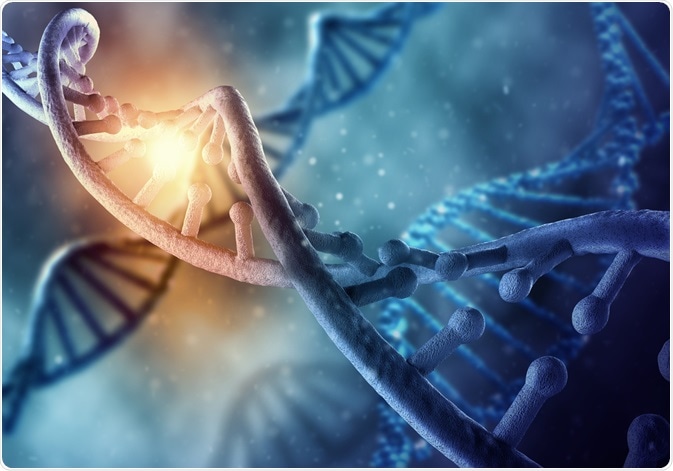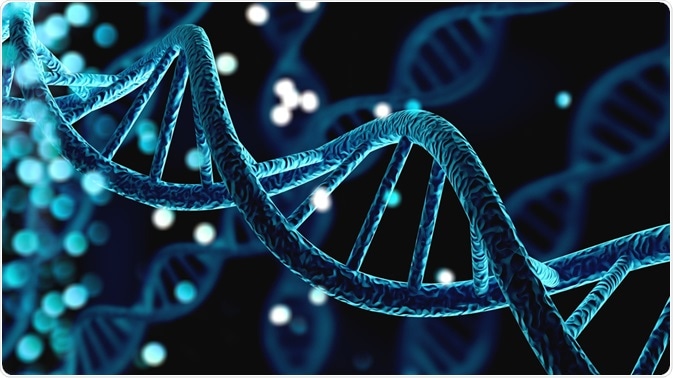DNA was first discovered in 1869 by Friedrich Miescher, a Swiss researcher, who was studying the composition of white blood cells when he isolated a molecule he termed nuclein: DNA and its associated proteins. He was able to determine that the molecule consisted of hydrogen, oxygen, nitrogen, and phosphorous, with the latter two in a unique ratio.

DNA. Image Credit: ESB Professional/Shutterstock.com
The composition and function of DNA
The structure of the molecule known as nuclein was later investigated by Russian researcher Phoebus Levene. He employed hydrolysis reactions to break up and analyze in detail the components of nuclein, proposing in 1919 that the molecule was constructed of a series of nucleotides composed of one of four bases, linked by a sugar molecule and a phosphate group. At this time it was impossible to determine the reason or order of the four identified nucleotide bases, and Levene himself suggested an alternating repeating 1-2-3-4 sequence.
In 1928 British scientist Frederick Griffith reported bacterial transformation by gene transfer, observing that DNA is taken up by bacteria sometimes caused phenotypic changes. He then applied non-pathogenic (R-strain) and capsule-wall bearing pathogenic (S-strain) strains of bacteria to mice, seeing that, when heat treated, the bacteria were no longer pathogenic, and concluding that the capsule-wall could not be the cause.
However, when injecting heat-inactivated pathogenic bacteria alongside live non-pathogenic bacteria, the mice died. Horizontal gene transfer had occurred between the bacteria, making the previously non-pathogenic strain pathogenic after acquiring the ability to produce a capsule wall.
Later, in 1944, Oswald Avery published a paper where it was demonstrated that DNA is the molecule responsible for heredity, as at the time proteins were considered the likely carriers of genetic information given their greater complexity, with 20 different amino acids involved in peptide sequences compared to the only four variations in nucleotides. He and his group utilized enzymes to selectively degrade either proteins or nucleic acids in S-strain, and subsequently co-cultured with R-strain bacteria. Those that had undergone nucleic acid removal were no longer able to transform R-strain bacteria, and thus the nucleic acids must be the source of gene transfer and thus genetic inheritance.
Martha Chase and Alfred Hershey later provided more confirmatory evidence in 1952 when studying bacteriophages, in which they labeled either the virus protein coat with radioactive sulfur or the virus nucleic acids with radioactive phosphorus. After infecting cells and subsequently removing the phage particles, only the radioactive phosphorus could be detected, thus it was the nucleic acids and not the proteins that were the vehicle of genetic material that the virus injected into cells.
The structure of DNA
Erwin Chargaff, an Austrian biochemist, reached two major conclusions in 1950: nucleotide composition of DNA varies among species, and that despite this, nucleic acids always maintain certain properties. In particular, he noted that the quantity of adenine in a nucleic acid was always similar to the quantity of thymine, while the same held true for guanine and cytosine, which was then termed Chargaff’s rule.
British scientists Rosalind Franklin and Maurice Wilkins worked extensively on producing X-ray crystallography images of DNA in the early 1950s, shortly before and during the construction of the double helix model more famously proposed by Watson and Crick.
Linus Pauling contributed hugely to the ability to calculate intermolecular distances and bond angles during his career, highly relevant to uncovering the structure of biomolecules, and in the late 1940s, he correctly proposed the way in which amino acids fit together to construct three-dimensional proteins, alpha-helical structures in particular.
Pauling also proposed a structure for DNA in 1953, also correctly attributing a helical structure which he defended on the terms that while a single strand of DNA would not be able to wind tightly enough, a three-stranded structure could. In Pauling’s model the three DNA strands were facing externally, and it was thought that these exposed nucleotides could be involved in intermolecular bonding with adjacent proteins and other biomolecules.
The internally-facing nucleotides of the two-strand model developed by Watson and Crick eventually proved correct, supported largely by the crystallographic images provided by Franklin and Wilkins.
Based on records and personal memoirs it would appear that when Rosalind Franklin was recruited she was promised a position as the head of the X-ray crystallography department at Kings College, London, while the reserved Maurice Wilkins, already employed there, was under the impression that she would serve in an assisting capacity. The pair, reportedly, did not collaborate well together, resulting in the physical model produced by Watson and Crick being far more widely acclaimed and lauded.
Minor changes to the model have been made since the early 1950s, though the major features remain undisputed: DNA is a double-stranded helix, with each strand connected by hydrogen bonds. Adenine always pairs with guanine, while thymine always pairs with cytosine, and the helix of most DNA runs clockwise up the molecule in a “right-handed” fashion.
The two strands are complementary, with distinct 5’ and 3’ ends, and externally facing functional groups on the bases are available for intermolecular bonding to allow cellular machinery to interact with the molecule.

DNA. Image Credit: Billion Photos/Shutterstock.com
Further Reading
Last Updated: Jan 17, 2022